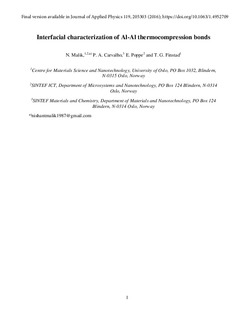Interfacial characterization of Al-Al thermocompression bonds
Journal article, Peer reviewed
Accepted version
Permanent lenke
http://hdl.handle.net/11250/2480823Utgivelsesdato
2016Metadata
Vis full innførselSamlinger
- Publikasjoner fra CRIStin - SINTEF AS [5801]
- SINTEF Digital [2501]
- SINTEF Industri [1565]
Sammendrag
Interfaces formed by Al-Al thermocompression bonding were studied by the transmission electron microscopy. Si wafer pairs having patterned bonding frames were bonded using Al films deposited on Si or SiO2 as intermediate bonding media. A bond force of 36 or 60 kN at bonding temperatures ranging from 400–550 °C was applied for a duration of 60 min. Differences in the bonded interfaces of 200 μm wide sealing frames were investigated. It was observed that the interface had voids for bonding with 36 kN at 400 °C for Al deposited both on Si and on SiO2. However, the dicing yield was 33% for Al on Si and 98% for Al on SiO2, attesting for the higher quality of the latter bonds. Both a bond force of 60 kN applied at 400 °C and a bond force of 36 kN applied at 550 °C resulted in completely bonded frames with dicing yields of, respectively, 100% and 96%. A high density of long dislocations in the Al grains was observed for the 60 kN case, while the higher temperature resulted in grain boundary rotation away from the original Al-Al interface towards more stable configurations. Possible bonding mechanisms and reasons for the large difference in bonding quality of the Al films deposited on Si or SiO2 are discussed.
